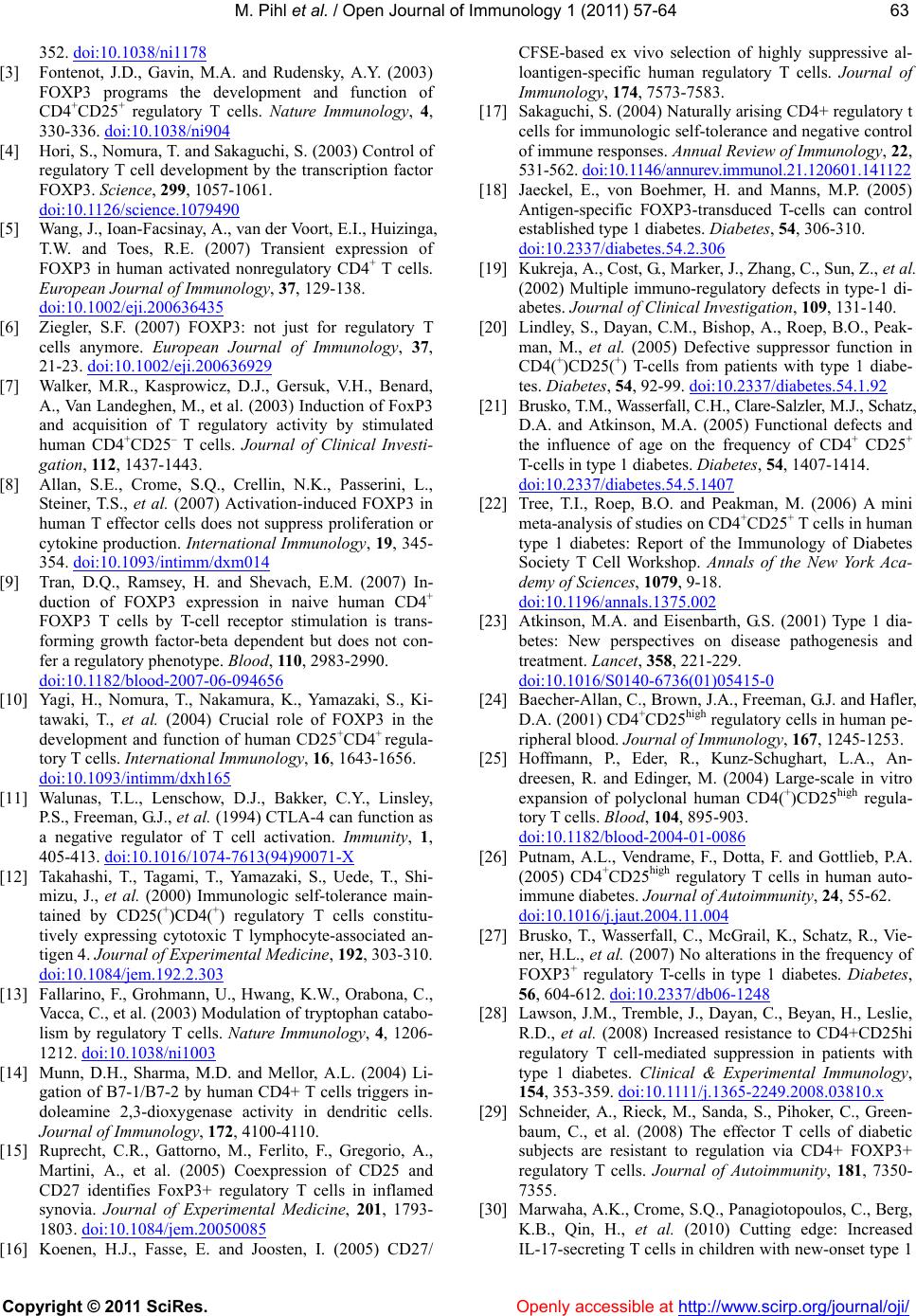
M. Pihl et al. / Open Journal of Immunology 1 (2011) 57-6 4
Copyright © 2011 SciRes. Openly accessible at http://www.scirp.org/journal/oji/
6363
352. doi:10.1038/ni1178
[3] Fontenot, J.D., Gavin, M.A. and Rudensky, A.Y. (2003)
FOXP3 programs the development and function of
CD4+CD25+ regulatory T cells. Nature Immunology, 4,
330-336. doi:10.1038/ni904
[4] Hori, S., Nomura, T. and Sakaguchi, S. (2003) Control of
regulatory T cell development by the transcription factor
FOXP3. Science, 299, 1057-1061.
doi:10.1126/science.1079490
[5] Wang, J., Ioan-Facsinay, A., van der Voort, E.I., Huizinga,
T.W. and Toes, R.E. (2007) Transient expression of
FOXP3 in human activated nonregulatory CD4+ T cells.
European Journal of Immunology, 37, 129-138.
doi:10.1002/eji.200636435
[6] Ziegler, S.F. (2007) FOXP3: not just for regulatory T
cells anymore. European Journal of Immunology, 37,
21-23. doi:10.1002/eji.200636929
[7] Walker, M.R., Kasprowicz, D.J., Gersuk, V.H., Benard,
A., Van Landeghen, M., et al. (2003) Induction of FoxP3
and acquisition of T regulatory activity by stimulated
human CD4+CD25– T cells. Journal of Clinical Investi-
gation, 112, 1437-1443.
[8] Allan, S.E., Crome, S.Q., Crellin, N.K., Passerini, L.,
Ste iner, T.S., et al. (2007) Activation-induced FOXP3 in
human T effector cells does not suppress proliferation or
cytokine production. International Immunology, 19, 345-
354. doi:10.1093/intimm/dxm014
[9] Tran, D.Q., Ramsey, H. and Shevach, E.M. (2007) In-
duction of FOXP3 expression in naive human CD4+
FOXP3 T cells by T-cell receptor stimulation is trans-
forming growth factor-beta dependent but does not con-
fer a regulatory phenotype. Blood, 110, 2983-2990.
doi:10.1182/blood-2007-06-094656
[10] Yagi, H., Nomura, T., Nakamura, K., Yamazaki, S., Ki-
tawaki, T., et al. (2004) Crucial role of FOXP3 in the
development and function of human CD25+CD4+ regula-
tory T cells. International Immunology, 16, 1643-1656.
doi:10.1093/intimm/dxh165
[11] Walunas, T.L., Lenschow, D.J., Bakker, C.Y., Linsley,
P.S., Freeman, G.J., et al. (1994) CTLA-4 can function as
a negative regulator of T cell activation. Immunity, 1,
405-413. doi:10.1016/1074-7613(94)90071-X
[12] Takahashi, T., Tagami, T., Yamazaki, S., Uede, T., Shi-
mizu, J., et al. (2000) Immunologic self-tolerance main-
tained by CD25(+)CD4(+) regulatory T cells constitu-
tively expressing cytotoxic T lymphocyte-associated an-
tigen 4. Journal of Experimental Medicine, 192, 303-310.
doi:10.1084/jem.192.2.303
[13] Fallarino, F., Grohmann, U., Hwang, K.W., Orabona, C.,
Vacca, C., et al. (2003) Modulation of tryptophan catabo-
lism by regulatory T cells. Nature Immunology, 4, 1206-
1212. doi:10.1038/ni1003
[14] Munn, D.H., Sharma, M.D. and Mellor, A.L. (2004) Li-
gation of B7-1/B7-2 by human CD4+ T cells triggers in-
doleamine 2,3-dioxygenase activity in dendritic cells.
Journal of Immunology, 172, 4100-4110.
[15] Ruprecht, C.R., Gattorno, M., Ferlito, F., Gregorio, A.,
Martini, A., et al. (2005) Coexpression of CD25 and
CD27 identifies FoxP3+ regulatory T cells in inflamed
synovia. Journal of Experimental Medicine, 201, 1793-
1803. doi:10.1084/jem.20050085
[16] Koenen, H.J., Fasse, E. and Joosten, I. (2005) CD27/
CFSE-based ex vivo selection of highly suppressive al-
loantigen-specific human regulatory T cells. Journal of
Immunology, 174, 7573-7583.
[17] Sakaguchi, S. (2004) Naturally arising CD4+ regulatory t
cells for immunologic self-tolerance and negative control
of immune responses. Annual Review of Immunology, 22,
531-562. doi:10.1146/annurev.immunol.21. 120601.14 1122
[18] Jaeckel, E., von Boehmer, H. and Manns, M.P. (2005)
Antigen-specific FOXP3-transduced T-cells can control
established type 1 diabetes. Diabetes, 54, 306-310.
doi:10.2337/diabetes.54.2.306
[19] Kukreja, A., Cost, G., Marker, J., Zha ng, C., Sun, Z. , et al.
(2002) Multiple immuno-regulatory defects in type-1 di-
abetes. Journal of Clinical Investigation, 109, 131-140.
[20] Lindley, S., Dayan, C.M., Bishop, A., Roep, B.O., Peak-
man, M., et al. (2005) Defective suppressor function in
CD4(+)CD25(+) T-cells from patients with type 1 diabe-
tes. Diabetes, 54, 92-99. doi:10.2337/diabetes.54.1.92
[21] Brusko, T.M., Wasserfall, C.H., Clare-Salzler, M.J., Schatz,
D.A. and Atkinson, M.A. (2005) Functional defects and
the influence of age on the frequency of CD4+ CD25+
T-cells in type 1 diabetes. Diabetes, 54, 1407-1414.
doi:10.2337/diabetes.54.5.1407
[22] Tree, T.I., Roep, B.O. and Peakman, M. (2006) A mini
meta-analysis of studies on CD4+CD25+ T cells in human
type 1 diabetes: Report of the Immunology of Diabetes
Society T Cell Workshop. Annals of the New York Aca-
demy of Sciences, 1079, 9-18.
doi:10.1196/annals.1375.002
[23] Atkinson, M.A. and Eisenbarth, G.S. (2001) Type 1 dia-
betes: New perspectives on disease pathogenesis and
treatment. Lancet, 358, 221-229.
doi:10.1016/S0140-6736(01)05415-0
[24] Baecher-Allan, C., Brown, J.A., Freeman, G.J. and Hafler,
D.A. (2001) CD4+CD25high regulatory cells in human pe-
ripheral blood. Journal of Immunology, 167, 1245-1253.
[25] Hoffmann, P., Eder, R., Kunz-Schughart, L.A., An-
dreesen, R. and Edinger, M. (2004) Large-scale in vitro
expansion of polyclonal human CD4(+)CD25high regula-
tory T cells. Blood, 104, 895-903.
doi:10.1182/blood-2004-01-0086
[26] Putnam, A.L., Vendrame, F., Dotta, F. and Gottlieb, P.A.
(2005) CD4+CD25high regulatory T cells in human auto-
immune diabetes. Journal of Autoimmunity, 24, 55-62.
doi:10.1016/j.jaut.2004.11.004
[27] Brusko, T., Wasserfall, C., McGrail, K., Schatz, R., Vie-
ner, H.L., et al. (2007) No alterations in the frequency of
FOXP3+ regulatory T-cells in type 1 diabetes. Diabetes,
56, 604-612. doi:10.2337/db06-1248
[28] Lawson, J.M., Tremble, J., Dayan, C., Beyan, H., Leslie,
R.D., et al. (2008) Increased resistance to CD4+CD25hi
regulatory T cell-mediated suppression in patients with
type 1 diabetes. Clinical & Experimental Immunology,
154, 353-359. doi:10.1111 /j.136 5- 2249.2008.03810.x
[29] Schneider, A., Rieck, M., Sanda, S., Pihoker, C., Green-
baum, C., et al. (2008) The effector T cells of diabetic
subjects are resistant to regulation via CD4+ FOXP3+
regulatory T cells. Journal of Autoimmunity, 181, 7350-
7355.
[30] Marwaha, A.K., Crome, S.Q., Panagiotopoulos, C., Berg,
K.B., Qin, H., et al. (2010) Cutting edge: Increased
IL-17-secreting T cells in children with new-onset type 1